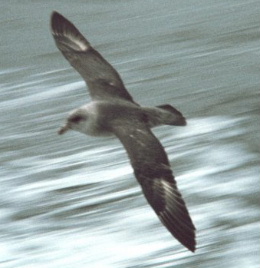Fulmar
|
|
| Fulmar | ||||||||||||
|---|---|---|---|---|---|---|---|---|---|---|---|---|
 Northern Fulmar | ||||||||||||
| Scientific classification | ||||||||||||
| ||||||||||||
| Species | ||||||||||||
|
F. glacialis (Linnaeus, 1761) |
The two Fulmars are closely related seabirds occupying the same niche in different oceans. The Northern Fulmar (Fulmarus glacialis), or just Fulmar lives the north Atlantic and north Pacific, whereas the Southern Fulmar (F. glacialoides) is, as its name implies, a bird of the southern oceans. These birds look superficially like gulls, but are unrelated, and are in fact petrels.
Fulmarus_glacialis_1_2.jpg
Both species breed on cliffs, laying a single white egg. Unlike many small to medium birds in the Procellariiformes they are neither nocturnal breeders, nor do they use burrows. The chicks can eject an evil smelling oil up to 2 m, which repels unwanted visitors. It will matt the plumage of avian predators, and can lead to their death.
They are highly pelagic outside the breeding season, like most tubenoses, feeding on fish, oil or offal.
Like other petrels, their walking ability is limited, but they are strong fliers, with a stiff wing action quite unlike the gulls. They look bull-necked compared to gulls, and have short stubby bills.
The northern species is grey and white, 43-52 cm in length with a 101-117 cm wingspan. The southern form is a paler bird with dark wing tips, 45-50 cm long, with a 115-120 cm wingspan.
The range of these species increased greatly last century due to the availability of fish offal from commercial fleets, but may contract because of less food from this source and climatic change.
The Sibley-Ahlquist taxonomy gives a radically different scientific arrangement for this group based on DNA studies.
Fulmarus_glacialis_1_8.jpg
Fulmarus_glacialis_1_1.jpg
See also
- Fulmar is also a British rocket.
- The Fairey Fulmar was a British carrier-borne fighter aircraft.bg:Полярен буревестник
da:Mallemuk de:Eissturmvogel es:Fulmar nl:Noordse stormvogel no:Havhest pl:Petrel
